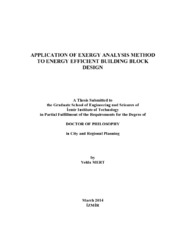Please use this identifier to cite or link to this item:
https://hdl.handle.net/11147/4231| Title: | Application of Exergy Analysis Method To Energy Efficient Building Block Design | Other Titles: | Ekserji Analizi Metodunun Enerji Etkin Yapı Adası Tasarımına Uygulanması | Authors: | Mert, Yelda | Advisors: | Saygın, Nicel | Keywords: | City planning Urban planning Energy efficient planning |
Publisher: | Izmir Institute of Technology | Abstract: | This dissertation introduces the exergy analysis method into urban planning field in order to find out the amount of energy that can be conserved in a building block when energy efficient design is applied. Two hypotheses are developed here: 1. Exergy analysis is a suitable tool for the built environment, and 2. Energy efficient design parameters provide energy saving in the built environment. A case study approach is undertaken in order to test the hypotheses stated above. To do this, first, the energy efficient design parameters have been derived from the literature and design alternatives are developed accordingly; second, data has been gathered from the case area for the exergy calculations; third, exergy analysis of existing building blocks and proposed design alternatives are carried out, and finally, the amount of decrease in the exergy loss due to energy efficient design is found out. The findings in this study show that the exergy efficiency of the existing building blocks is nearly 2 %, while the proposed design alternatives are nearly 10-11 %. The overall exergy loads of the alternative plans are found as 166.3W, 225.1W, 142.5W, 137.8W and 184.8W respectively for winter and 105.4W, 140.0W, 89.9W, 86.3W and 125.3W respectively for summer on a housing unit basis. These results are much better when compared to the existing situation per housing unit which is 1079W (winter) and 1173W (summer). The best alternative energy efficient planning and design brings 1631 W (winter) and 2810W (summer) of exergy saving that corresponds to 799 TL/year and 978 kg/year reduction in CO2 greenhouse gases emission per housing unit. This data shows that the expected results and are in harmony with the literature. As a result, the suitability and importance of the exergy analysis on the built environment is proved by revealing the energy conservation and sustainable use of energy through using energy efficient design parameters. | Description: | Thesis (Doctoral)--Izmir Institute of Technology, City and Regional Planning, Izmir, 2014 Includes bibliographical references (leaves: 119-125) Text in English; Abstract: Turkish and English Full text release delayed at author's request until 2017.04.03 |
URI: | http://hdl.handle.net/11147/4231 |
| Appears in Collections: | Phd Degree / Doktora Sürdürülebilir Yeşil Kampüs Koleksiyonu / Sustainable Green Campus Collection |
Files in This Item:
| File | Description | Size | Format | |
|---|---|---|---|---|
| 10013222.pdf | DoctoralThesis | 5.35 MB | Adobe PDF |  View/Open |
CORE Recommender
Page view(s)
336
checked on Apr 21, 2025
Download(s)
192
checked on Apr 21, 2025
Google ScholarTM
Check
Items in GCRIS Repository are protected by copyright, with all rights reserved, unless otherwise indicated.